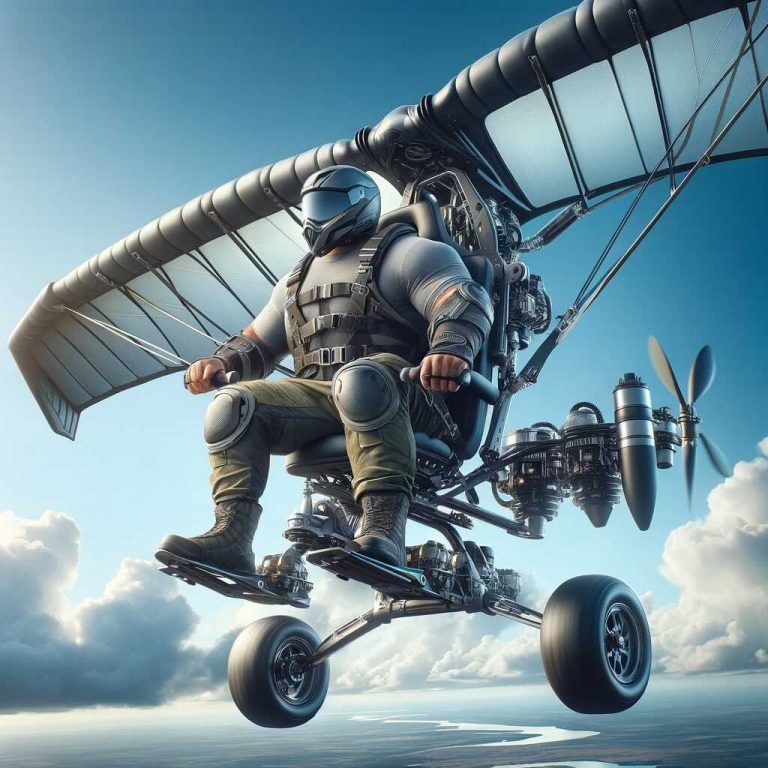Paragliding and paramotoring are two exhilarating recreational activities that involve flying with the help of wings, harnesses, and the power of the wind. While these activities share some similarities, they are distinct in their own right. Many enthusiasts wonder if it’s possible to interchange the equipment between these two pursuits, particularly when it comes to using a paramotor wing for paragliding.
The answer to the question to whether you can use a paramotor wing for paragliding. is yes, it is possible to use a paramotor wing for paragliding. However, there are important factors and considerations to keep in mind, which we will explore in this article.
Understanding Paramotoring and Paragliding
Before we delve into whether you can use a paramotor wing for paragliding, it’s essential to understand the fundamental differences between these two activities.
Paramotoring:
Paramotoring, also known as powered paragliding, involves flying with a motorized backpack unit, which propels the pilot and a paragliding wing into the sky. This motor, often a small two-stroke engine, is attached to a lightweight frame and is equipped with a propeller. The pilot typically runs to gain momentum before taking off and can also use the motor to gain altitude or maintain flight.
Paramotoring is known for its simplicity and accessibility, as it requires minimal training and can be practiced in relatively small areas. The motor provides added control, allowing pilots to take off from flat ground and land in a controlled manner.
Paragliding:
Paragliding, on the other hand, is a non-motorized form of flight. Paragliders use a similar wing to paramotor wings but do not have a motorized unit attached to their harness. Instead, paragliders rely solely on natural wind currents to gain altitude and maintain flight. They typically launch from elevated locations such as hills or mountains and rely on the skill of reading wind and thermals to stay aloft.
Paragliding requires more training and skill development than paramotoring, as pilots must learn to work with the natural elements for takeoff, landing, and controlling their flight. It’s considered a pure form of free-flight, offering a unique connection to the elements and the sensation of soaring like a bird.
Key Differences Between Paramotor Wings and Paragliding Wings
To determine if you can use a paramotor wing for paragliding, it’s crucial to understand the differences between the two types of wings. While they may appear similar at a glance, they have distinct characteristics that are designed to suit their respective activities.
1. Shape and Design:
Paramotor wings are specifically designed for powered flight. They often have a flatter profile and more reinforced leading edges to handle the added stress of the motor’s thrust. These wings are built to be stable and forgiving, making them suitable for beginners in the paramotoring world.
Paragliding wings, on the other hand, have a different shape and design optimized for gliding without a motor. They tend to have a more pronounced and rounded profile to maximize lift and maneuverability in free-flight conditions. Paragliders require a higher level of skill to handle the wing’s responsiveness to natural wind currents.
2. Weight and Inflation:
Paramotor wings are generally heavier than paragliding wings due to the added weight of the motor and frame. They are designed to be inflated easily with the help of the motor’s thrust, making takeoff a straightforward process.
Paragliding wings are lighter and require a different technique for inflation. Paragliders rely on a forward launch, where they run forward to fill the wing with air and generate lift. This technique requires more skill and practice.
3. Speed and Handling:
Paramotor wings are built to handle the speed and power generated by the motor. They have a more stable and predictable flight pattern at various speeds, which is ideal for paramotor pilots who may need to adjust their speed for different phases of flight.
Paragliding wings are designed for a wider range of speeds and are highly maneuverable. Paragliders need to control their wing’s speed and angle of attack to stay in the air, which requires a higher level of piloting skill.
Can I Use a Paramotor Wing for Paragliding?
Now that we have a clear understanding of the differences between paramotor wings and paragliding wings, let’s address the central question: Can you use a paramotor wing for paragliding? The short answer is yes, it’s possible, but there are several important considerations to keep in mind.
1. Skill Level:
If you are an experienced paramotor pilot, you may find it easier to transition to paragliding using a paramotor wing, as you already have some knowledge of wing control and flying dynamics. However, if you are entirely new to both activities, it’s generally recommended to start with a dedicated paragliding wing and receive proper training.
2. Wing Compatibility:
Not all paramotor wings are suitable for paragliding, and not all paragliding wings are suitable for paramotoring. You should consult with experienced pilots and instructors to determine if your specific paramotor wing is appropriate for paragliding. Some paramotor wings may be too heavy or have characteristics that make them less than ideal for paragliding.
3. Launch and Landing Techniques:
Launching a paramotor wing for paragliding requires a different technique than launching for paramotoring. Paragliders use a forward launch, while paramotor wings rely on the motor for inflation. You will need to learn and practice the paragliding launch technique to safely take off without a motor.
Similarly, landing a paramotor wing in paragliding conditions can be challenging, as you won’t have the motor’s thrust to assist with a controlled descent. Learning proper paragliding landing techniques is essential for your safety.
4. Environmental Factors:
Paragliding relies on natural wind currents and thermals for lift, while paramotoring provides consistent powered flight. As a result, you will need to develop a keen understanding of weather conditions and how they affect paragliding flight. Wind direction, speed, and thermals play a significant role in paragliding, and you must be prepared to adapt to changing conditions.
5. Training and Certification:
Regardless of your previous experience with paramotoring, it’s essential to undergo proper paragliding training and certification if you intend to use a paramotor wing for paragliding. Paragliding schools and instructors can provide valuable instruction on wing control, meteorology, and safety procedures specific to free-flight.
The Benefits of Using a Paramotor Wing for Paragliding
While there are challenges and considerations when using a paramotor wing for paragliding, there are also potential benefits to this crossover:
1. Familiarity with Wing Handling:
If you are already comfortable with the handling characteristics of your paramotor wing, transitioning to paragliding with the same wing can reduce the learning curve compared to starting with a completely new wing.
2. Equipment Cost Savings:
Using your paramotor wing for paragliding can save you money on purchasing a separate paragliding wing. Paragliding wings can be expensive, and if you already own a paramotor wing, it may be more cost-effective to use it for both activities.
3. Versatility:
Having a paramotor wing that can also be used for paragliding gives you the flexibility to enjoy both forms of flight with a single piece of equipment.
Important Safety Considerations
Safety should always be the top priority when engaging in any form of flying, whether it’s paramotoring, paragliding, or any other aviation activity. Here are some crucial safety considerations when using a paramotor wing for paragliding:
1. Proper Training:
Ensure that you receive proper training and certification from a reputable paragliding school or instructor. Training is essential to understand the nuances of paragliding, including launch and landing techniques, reading weather conditions, and responding to emergencies.
2. Wing Inspection:
Before using your paramotor wing for paragliding, have it inspected by a qualified wing technician or manufacturer to ensure it is in good condition and suitable for paragliding. Any damage or wear and tear should be addressed promptly.
3. Weather Awareness:
Develop a deep understanding of weather patterns and how they affect paragliding conditions. Always check weather forecasts and be prepared to postpone or cancel flights in adverse conditions.
4. Emergency Procedures:
Familiarize yourself with emergency procedures specific to paragliding, including how to handle collapses, stalls, and other challenging situations. Having the knowledge and skills to respond to emergencies can make a significant difference in your safety.
5. Legal Requirements:
Check local regulations and requirements for paragliding in your area. Some regions may have specific rules and permits for paragliding, and it’s essential to comply with them.
6. Risk Assessment:
Before each flight, conduct a thorough risk assessment, considering factors such as wind conditions, terrain, and your personal skill level. Don’t hesitate to cancel a flight if you feel it is unsafe.
Conclusion
Using a paramotor wing for paragliding is possible, but it comes with its own set of challenges and considerations. While experienced paramotor pilots may find it easier to transition to paragliding with their existing equipment, beginners are encouraged to start with dedicated paragliding wings and undergo proper training.
Safety should always be a top priority in both paramotoring and paragliding. Regardless of your experience level, invest in comprehensive training, stay informed about weather conditions, and be prepared to respond to emergencies. Using the right equipment and adhering to safety protocols will help you enjoy the thrill of both paramotoring and paragliding while minimizing risks.
Remember that the joy of flight in any form is a result of preparation, practice, and a deep respect for the forces of nature that make it all possible. So, whether you choose to use a paramotor wing for paragliding or opt for dedicated equipment, always prioritize safety and enjoy the incredible experience of soaring through the skies.








